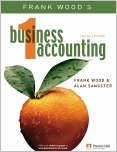Business Accounting is the world's bestselling textbook on bookkeeping
and accounting. It provides students with a clear and straight forward
introduction to the core techniques and skills required to fully understand the
foundations of financial accounting. Each topic is back up by a wealth of worked
examples, as well as a rich pool of self assessment material, so that students can monitor
their own progress and understanding.
Features
- Hundreds of review questions, activities and multiples choice questions, so that
students can judge how well they understand and can apply what they are learning.
- Real exam questions at the end of every chapter and exam guidance to help students
prepare better for exams and improve their results.
- Intensive coverage of the underlying techniques and skills of accounting preparing
students to better understand double entry bookkeeping and preparation of accounting
information.
- Comprehensive coverage of how to prepare accounts of sole traders, partnerships,
companies and groups providing deeper understanding of the differences.
- Universal approach appealing to students from a broad range of educational backgrounds.
Contents
Notes for Teachers and Lecturers
Notes for Students
PART ONE: INTRODUCTION TO DOUBLE ENTRY BOOKKEEPING
1. The accounting equation and the balance sheet
2. The double entry system for assets, liabilities and capital
3. The asset of stock
4. The effect of profit or loss on capital and the double entry system for expenses and
revenues
5. Balancing of accounts
6. The trial balance
PART TWO: THE FINANCIAL STATEMENTS OF SOLE TRADERS
7. Trading and profit and loss accounts: an introduction
8. Balance Sheets
9. Trading and profit and loss accounts and balance sheets: further considerations
10. Accounting Concepts
PART THREE: BOOKS OF ORIGINAL ENTRY
11. Books of original entry and ledgers
12. The banking system
13. Cash books
14. The sales day book and the sales ledger
15. The purchases day book and the purchases ledger
16. The returns day books
17. The journal
18. The analytical petty cash book and the imprest system
19. Value added tax
20. Columnar day books
21. Employees' pay
22. Computers and accounting
23. Computerised accounting systems
PART FOUR: ADJUSTMENTS FOR FINANCIAL STATEMENTS
24. Capital and revenue expenditure
25. Bad debts, provisions for doubtful debts, provisions for discounts on debtors
26. Depreciation of fixed assets: nature and calculations
27. Double entry records for depreciation
28. Accruals and prepayments and other adjustments for financial statements
29. The valuation of stock
30. Bank reconciliation statements
31. Control accounts
32. Errors not affecting trial balance agreement
33. Suspense accounts and errors
PART FIVE: SPECIAL ACCOUNTING PROCEDURES
34. Introduction to accounting ratios
35. Single entry and incomplete records
36. Receipts and payments accounts and income and expenditure accounts
37. Manufacturing accounts
38. Departmental accounts
39. Cash flow statements
40. Joint venture accounts
PART SIX: PARTNERSHIP ACCOUNTS AND COMPANY ACCOUNTS
41. Partnership accounts: an introduction
42. Goodwill for sole traders and partnerships
43. Revaluation of partnership assets
44. Partnership dissolution
45. An introduction to the financial statements of limited liability companies
46. Purchase of existing partnership and sole traders' businesses
PART SEVEN: AN INTRODUCTION TO FINANCIAL ANALYSIS
47. An introduction to the analysis and interpretation of accounting statements
PART 8: AN INTRODUCTION TO MANAGEMENT ACCOUNTING
48. An introduction to management accounting
APPENDICES
1. Answers to review questions
2. Answers to multiple-choice
3. Glossary
Index
Paperback, 792 pages


